The New Great Compromise: Nuclear Energy’s Broad Appeal
Whenever I turn on the news and hear how America should generate its electric power, hardly any "expert" cites nuclear energy. Energy discussions are especially prominent now, since the United States decided to pull out of the Paris climate agreement. What is so striking to me is that nuclear is almost never talked about, and when it is, it's normally an afterthought to other sources of energy. America's largest source of clean power is nuclear, which makes up roughly 20 percent of all power generation, and it should take a more prominent role. This got me wondering, why isn't nuclear talked about more as a solution? As a nuclear engineer, my opinion, albeit a bit biased, is that we need nuclear energy in our energy mix.
Looking at nuclear power's favorability, it becomes obvious that the industry as a whole has a P.R. problem. According to a Gallup poll [1], the nuclear industry, for the first time in the survey's history, had more participants oppose nuclear power, than support it (that fell outside the margin of error). The report stated that as Americans become less concerned about energy, most likely due to low prices at the gas pump, the less concerned they are about where they get their energy.
There is a lot of variation in nuclear power favorability polling. While Gallup reports that most of the public is opposed to nuclear, the Bisconti poll from NEI says that the favorability is stronger than ever. Both surveys have merit, and you should draw your own conclusions from each. However, the reason for the variance is most likely due to one sample having more knowledge on nuclear power than the other, which has been shown to have a strong influence on whether or not one is for or against it.
If you look at the news recently, it's not surprising to guess why the favorability for nuclear has dropped so much. More and more Americans are getting the majority of their information in 140 characters or less, and nuclear isn't a part of the conversation on how to tackle energy problems. It's clear that nuclear needs to be part of the conversation, because given the current political climate, it is the only source of energy that can be palatable to both sides.
In this article, I hope to explain why both sides should be completely behind nuclear, and hopefully dispel some rumors along the way. While all the reasons below are not mutually exclusive to one side, the reasons selected for the left or right were chosen based on the cornerstones of the party's platform.
Part 1: The Case for the Right
It's dangerous to generalize, but for the most part those on the right view nuclear as a part of an "All of The Above" energy policy. This can be translated as "whatever is available, economic, and practical, should be where we get our energy." As it stands currently, nuclear is generally an afterthought to fossil fuels. America's vast reserves of natural gas, which are seen as a blessing, is generally at the top of Republican lawmakers' minds on how we should be getting our energy; However, it is not as hard to convince Republicans on the merits of nuclear.
According to Gallup, nuclear favorability is strongly correlated with energy cost, rather than nuclear accidents. (Note: Favorability among Independents and Democrats increased after Fukushima.) Gallup suggests that if Americans are paying less at the pump, the perceived energy crisis is viewed as less serious. Because of this, fewer Americans see the need for nuclear as an alternative power source. This is a dangerous perception, and leads me to my first point, energy diversity and cost.
- Energy Diversity and Cost
Americans enjoy some of the cheapest energy in the world, in part largely due to its deregulated electricity market and the variety of sources from which we get our energy. Thanks to the way many energy markets in the United States are structured, consumers are almost always ensured to get the cheapest price from the cheapest source, but this is only when there is a wide selection of sources available. As coal plants are gradually retired, they are replaced with natural gas, which is, at the moment, cheap. The problem with this is that retired nuclear plants are also replaced by and large with natural gas, which causes a net gain in emissions. Emission mitigation is not a large talking point on the right, so this will not be discussed in this section.
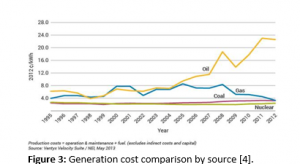
Figure 1: Generation cost comparison by source [4]
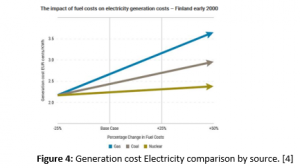 The figure to the right demonstrates how sensitive the cost of electricity produced by natural gas is, when the price of natural gas changes. Right now, since gas is cheap, electricity is as well. The cost of nuclear generation hardly ever changes, being the least sensitive to changes in fuel price. This is an invaluable property, unique to nuclear energy that would be part of energy "insurance" for the U.S. electricity consumer. If gas prices were to go up again, we would have nuclear to fall back on at a stable and predictable price. The importance of this to the average American's pocketbook, and economic stability, cannot be understated enough. A diverse energy portfolio with nuclear as the backbone provides the cheapest, most stable energy.
The figure to the right demonstrates how sensitive the cost of electricity produced by natural gas is, when the price of natural gas changes. Right now, since gas is cheap, electricity is as well. The cost of nuclear generation hardly ever changes, being the least sensitive to changes in fuel price. This is an invaluable property, unique to nuclear energy that would be part of energy "insurance" for the U.S. electricity consumer. If gas prices were to go up again, we would have nuclear to fall back on at a stable and predictable price. The importance of this to the average American's pocketbook, and economic stability, cannot be understated enough. A diverse energy portfolio with nuclear as the backbone provides the cheapest, most stable energy.
- Jobs, Jobs, Jobs
This is generally the cornerstone for many GOP campaigns, and was one stated numerous times during the 2016 Trump campaign. Not that jobs aren't important to the left as well, but this was one of the main reasons Trump cited for pulling out of the Paris climate agreement. If there is one reason to support nuclear power on the right, it is because of the high-paying, skilled, and diverse number of jobs it has to offer.
According to the Department of Energy's annual energy employment report [5], the U.S. nuclear power industry employs roughly 68,000 people, with about 100 reactors in operation. While this isn't as high as solar's 300,000+ jobs cited in the same report, it is important to note that most of those employed by the nuclear industry are essentially operating and maintaining the plants and jobs related to O&M. Solar's high job numbers are mostly due to construction, or installation of solar panels. These jobs are also not organic, and are the result of large subsidies that arguably create an uneven playing field for all energy sources. This creates the need to look at job creation on a leveled basis, which is seen in the figure below.

Figure 3: Energy job creation comparison per 1,000 MW of generation capacity [3]

Table 1: Comparison of media hourly wage for all utility employees by sector via Bureau of Labor Statistics
As evident above, the nuclear industry compensates its employees much more than other sectors. This is due to the fact that the nuclear workforce is highly skilled and specialized, which offers a certain amount of job security to those working in the field. Related to the previous point, the fact that nuclear can produce electricity the least expensively and has the highest payout to its employees is certainly a win-win for the technology. It's no wonder that 84 percent of those living near a nuclear plant view it favorably, much higher than the national average (figure 1) [6].
- Leaders or Followers?
Republicans generally take great national pride in areas in which the country leads. We are considered technology leaders in many areas, partly due to our emphasis on individual freedoms. This allows our artists, creators, engineers, scientists, etc., to really think outside of the box. The advanced nuclear industry is no exception to this. North America boasts the largest number of advanced nuclear startups, more than anywhere else in the world, with each startup having its own unique take on nuclear energy.

figure 4: Number of advance nuclear startups by country [8]
Part 2: The Case for the Left
We live in an age where science has become hyper-political. Hard scientific fact and statistics are open to subjective reasoning, and both parties will pick sides. In terms of climate change, Democrats in general perceive this as the biggest threat facing humanity, and Democratic policy reflects this. The problem with some of this policy is that it is often dictated by environmental groups, such as the Sierra Club, the Natural Resources Defense Council, and others, which not only reject the benefits of such items as GMOs and the insecticide DDT, but more importantly the effect that nuclear has, and could potentially have, on mitigating climate change. The irony of the matter is that a person can be skeptical of climate change, support nuclear, and be part of the solution, whereas someone who believes in climate change and is anti-nuclear is part of the problem. Nuclear's effect in reducing emissions is well documented, and like for the Republicans has a plethora of reasons why Democrats should whole-heartedly support nuclear energy.
- Proven Emissions Reductions and Land Conservation
Many environmentalists are beginning to acknowledge nuclear power's role in reducing carbon emissions. A perfect example of this is to compare France and Germany side-by-side. The research and policy group Environmental Progress, and others, have done just that.
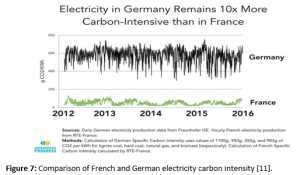
Figure 5: Comparison of French and German electricity carbon intensity [11].
One of the many problems with renewables is the intermittency. Even though Germany has had a massive influx of renewable energy to the grid, every watt of installed capacity must be backed up with a reliable source. This in Germany's case is lignite, a.k.a. brown coal, and is the reason for the flat line in carbon emissions. The wind doesn't always blow, and the sun doesn't always shine, and when it does in excess, we have no means of storing that energy. Not to mention, storing energy is not as efficient as directly transmitting it.
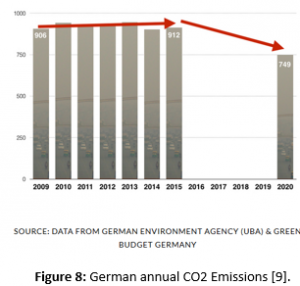
Figure 6: German annual CO2 emissions [9].
However, the area needed by a nuclear plant (assuming a land use intensity of 2.8 km2/TWhr/yr/) [13] would be about 2,200 square miles, or an area just smaller than the state of Delaware. In other words, if we were to keep up with annual energy increases with either 100 percent wind or nuclear, it would take roughly 28 years of using only nuclear to equal the land area used by wind for only one year. Furthermore, this only addresses the increase in consumption, not what is already installed.
In terms of CO2 reduction and land conservation, one of the best solutions to this is nuclear. While the Intergovernmental Panel on Climate Change recommends using all sources of clean energy, nuclear must be given credit in the role it will play in combating climate change. It's great that wind and solar technology have made such great improvements and it should be used when possible and practical. However, the expectation that we can sustain a modern, energy intensive society with only renewables is impractical.
- Poverty alleviation
The film Pandora's Promise and Environmental Progress do an excellent job of explaining this issue [14], but the undeveloped world is developing, and fast. Energy consumption is expected to grow significantly in the coming years, and these developing nations are demanding more electricity. As world economies grow, people in these countries start clamoring for items that many here in America take for granted. It's nearly impossible to imagine a sought-after modern commodity these days that doesn't require electricity in some way. To add to these countries' newfound consumerism, their citizens also start moving to the cities [9]. Tasks such as farming and pumping water become automated and electrified. Once this starts happening, it would be nearly impossible to tell these people to return to their old ways of life. Think of how big an inconvenience it is to us when the power goes out, but that is basically what we are selling to the developing world when we push renewables on them.
To improve the quality of life in the developing world, we need cheap, centralized, always-on power. Moreover, to combat climate change, all of this energy needs to be clean. Renewables are expensive for underdeveloped economies, and fossil fuels are dirty. Nuclear is perfectly suited both for keeping the air clean, and providing the affordable energy required for improving the majority of the world's population's lives. Democrats are often known for sticking up for the little guy. By embracing nuclear power as an energy solution for the developing world, there is a massive potential for so many people's lives to be improved.
- It's the Cleanest Source
Nuclear energy, by default, does not emit CO2. Sure, you can calculate a carbon footprint based off the mining of uranium, pouring the concrete, or the cities that will burn because of nuclear warfare due to nuclear proliferation [10], but to say that nuclear energy is not a clean source of energy is disingenuous.
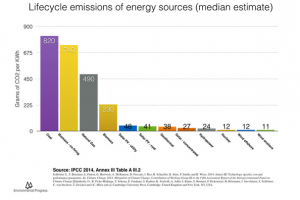
Figure 7: Lifetime emissions of energy sources by source.
However, the carbon intensity of the manufacturing process for construction materials is a legitimate concern, and is important to look at on a levelized basis. To many people's surprise, nuclear energy is one of the cleanest sources of energy available. When looking at the lifetime emissions by source, it ranks even less than solar. When looking at resource intensity (amount of materials used to construct), the results are even more interesting.
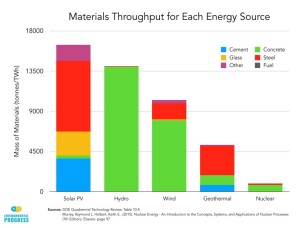
Figure 8: Energy source material intensity.
Of course, one windmill or one solar panel doesn't use as many resources as an entire fossil or nuclear plant, but in terms of conservation, it is much better to use an energy dense source. To replace a nuclear plant with only renewables would take tons (literally) of material to get the same energy output. Producing all this material requires the use of coal, and therefore carbon emissions.
Now you can't talk about nuclear being a clean source when there is a waste issue, but for me this is a non-issue. Most nuclear waste is not "waste". Used reactor fuel can be reprocessed and reused time and time again with technology that has been proven (i.e., the Integral Fast Reactor or IFR). While programs like the IFR still have a waste stream, its waste is radioactive for a much shorter time period. This waste still has to be stored safely, but the way it's stored now is incredibly sound. Waste from these reactors is stored in concrete storage casks that are astonishingly resilient. Tests have been done where these casks were placed on train tracks, and were hit with trains and rocket-powered sleds. This may sound excessive, but these casks held up [15].
Given the fact that nuclear boasts the lowest carbon footprint, low resource intensity, and completely manageable waste stream, it is a clear front runner for cleanest energy source.
Conclusions
There are more reasons than the six above I mentioned for why individuals in each party should support nuclear. A lot of these issues are interchangeable for parties, and are more poignant to an individual based on personal belief rather than political belief. Regardless of where you stand on the America's decision to pull out of the Paris climate agreement, there is al solution that both parties can get behind, and it is nuclear power. Any climate agreement or effort to mitigate climate change needs to use nuclear energy as a solution. The benefits of doing so are much greater than reducing emissions, as illustrated above. Even with all these benefits, nuclear is not talked about as much as it should be, and is generally an afterthought to policymakers. The nuclear solution can weather the changing of administrations and accomplish an end-goal with benefits for everyone, regardless of their beliefs. If you want to tackle climate change, create jobs, help billions of people in poverty, and or grow the economy in this multi-billion-dollar industry, now is the time to advocate and spread the message. Too much is on the line for nuclear to be just an afterthought.
References
- Riffkin, Rebecca. "For First Time, Majority in U.S. Oppose Nuclear Energy." com. Gallup Inc., 18 Mar. 2016. Web. 05 June 2017.
- "May 2016 National Industry-Specific Occupational Employment and Wage Estimates-Sector 22-Utilities." Https://www.bls.gov/oes/current/oessrci.htm#22. Bureau of Labor Statistics, May 2016. Web. 6 June 2017. Sector 22-Utilities and subsections by sector were used.
- "Economic Growth & Job Creation." Economic Growth & Job Creation - Nuclear Energy Institute. N.p., n.d. Web. 06 June 2017.
- "The Economics of Nuclear Power." World Nuclear Association. N.p., Apr. 2017. Web. 6 June 2017
- United States. Department of Energy. US Energy and Employment Report. N.p., Jan. 2017. Web. 6 June 2017.
- Nuclear Energy Institute. Nuclear Plant Neighbor Survey Shows Strong Support for Current and New Power Plants . Washington D.C.: Nuclear Energy Institute, 2009.
- Milko, John, and Todd Allen. "The Global Race for Advanced Nuclear." Third Way. N.p., 18 May 2017. Web. 6 June 2017.
- The Clean Energy Program, and Erin Burns. "Nuclear Energy Policy Roadmap." Third Way. N.p., 7 Apr. 2017. Web. 6 June 2017.
- "Key Questions." Environmental Progress. N.p., n.d. Web. 07 June 2017.
- Barton, Charles. "Jacobson, Beyond Cherry Picking." Nucleargreen. N.p., n.d. Web. 7 June 2017.
- "Global Overview." Environmental Progress. N.p., n.d. Web. 07 June 2017.
- Ridley, Matt. "The Utter Complete Total Fraud of Wind Power." Rod D. Martin. N.p., 02 June 2017. Web. 07 June 2017.
- Singh, Prastuti. "Nuclear Energy Comparison with Alternative Energy Sources." Nuclear Energy Comparison with Alternative Energy Sources. Stanford University, 18 Mar. 2015. Web. 07 June 2017
- Stone, Robert. "Pandora's Promise (2013)." Pandora's Promise. N.d. IMDb. Web. 07 June 2017.
- "Nuclear Flask Endurance Testing in USA." YouTube. YouTube, 02 May 2007. Web. 07 June 2017.
 Doug Hardtmayer is a graduate student studying nuclear engineering at The Ohio State University. His research is focused on pyroprocessing and fuel assessment. He is a member of the American Nuclear Society Social Media Team.
Doug Hardtmayer is a graduate student studying nuclear engineering at The Ohio State University. His research is focused on pyroprocessing and fuel assessment. He is a member of the American Nuclear Society Social Media Team.

